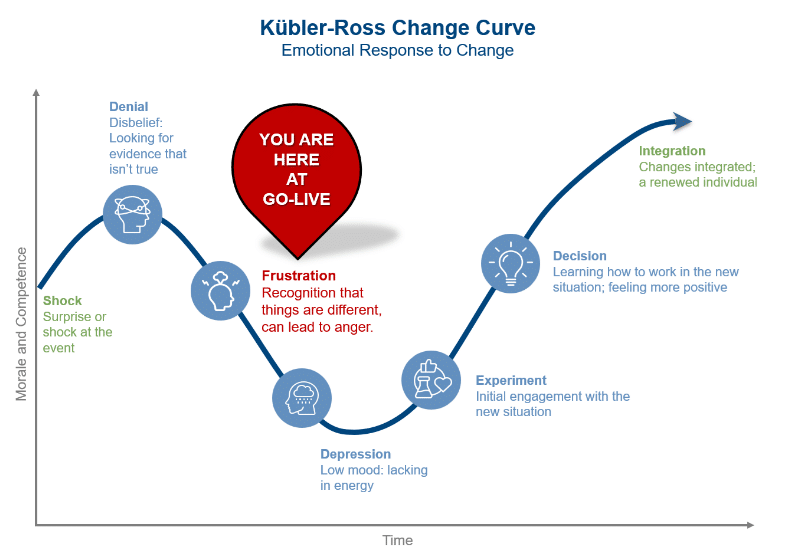From Go-Live to Thrive: The Importance of Post-Go-Live IT Support Planning and Working with a Partner Who Can Evolve with You

The time following an EHR or ERP implementation is often tumultuous. It is a period of heightened organizational change that is stressful for individuals and represents a risk to patient care and financial health. The organization is trying to reach a stable clinical, financial, and operational state while clinicians, revenue cycle staff, and others work through the common response to large-scale change. IT’s ability to focus on supporting individuals through the transition and build trust in new tools is paramount during this critical time. However, with so much activity and competing priorities post-go-live, it can be easy to fall into a purely “reactive” state of mind without a support plan.
Trying to Achieve Stability While End Users Respond to Change
The Kübler-Ross Change Curve is a well-known framework that outlines the typical emotional response to change. For technology end users, go-live is near the start of the curve. Change takes time, and each individual moves through emotional response at their own pace. Achieving engagement with the new system may come hours, days, weeks, or even months later.
Few hospitals and health systems are in a stable state immediately after go-live – and while your organization is trying to achieve clinical, financial, and operational stability, your end users may still be working through their frustration or experimenting with how the system works.

Your IT support team needs to be highly efficient and focused to help drive the needed clinical, financial, and operational stability during this delicate time. However, it is important to remember that while a Command Center is typically used to address the immediate needs of the go-live, IT is settling into a new world and a new order of operations.
It can be easy to lose focus without a clear plan for post-go-live IT support in place before the implementation. IT departments can quickly find themselves overwhelmed, whether trying to stabilize the go-live itself, preparing for the next update, navigating plans to roll out the new EHR to affiliates, or just working through the backlog of optimizations that end users have been promised.
The cost of an overwhelmed and unfocused IT support team can add up quickly. It is more than just the inefficiencies and additional work being done; it is the high-priority strategic projects that are not being completed.
Successfully Planning to “Thrive After Go-Live”
Having a formal strategy for post-go-live IT support sounds simple. Still, the reality is that most hospitals and health systems struggle to find time for post-live focus before the implementation. Discussions about how support will work after go-live have undoubtedly occurred, but there is rarely an explicit strategy for post–go-live IT support or a way to effectively integrate leaders focused on the IT support strategy into the implementation planning process. Additionally, given activity and demands of implementation – and the level of expertise required to navigate priorities – the safest and most cost-effective approach for most health systems will be to work with an experienced partner who can evolve with you through each key transition.
Three keys for any hospital or health system to “thrive after go-live” are:
1.) Ensure there is a well-defined support plan in advance that accounts for both “knowns” and “unknowns.”
Begin planning for support when you begin planning for go-live. When decisions are being made about the implementation, an internal leader who is thinking about the implications of those decisions on IT support can help prepare you for future success. For example, how will steering and governance evolve? When and how will operational stakeholders be available to provide input and guidance? Is your service catalog updated to accommodate new EHR or ERP request fulfillment needs and service levels? What staffing levels and expertise will be necessary to sustain your new technology?
There are many common issues related to post-go-live support that every organization should plan for ahead of time. How will you work down a backlog of tickets collected during go-live? How quickly do your IT teams need to prioritize updates and upgrades? What list of optimizations have you collected and promised to deploy post-live? At the same time, it is also important to recognize there is no way to predict every hurdle that will come up. By building a level of flexibility into your go-live support plan ahead of time, your team will have the bandwidth to quickly pivot to address any unknowns that inevitably arise without needing to resort to expensive and short-term fixes. Ask yourself: are you prepared for post-project analyst attrition? Can you release your project consultants?
2.) Define what “success” should look like at distinct intervals post-go-live.
A crucial part of planning for IT support post-go-live is clearly defining in advance what success should look like at specific intervals in the weeks and months after the implementation. Go-live is just the start, a kickoff for your new operating model. Your IT support needs will evolve each week and month as clinicians, revenue cycle staff, and others work through the change curve. Progress will be incremental, and something considered a “success” during the first week after go-live could represent a significant failure just three months later.
In the months leading up to go-live, your designated IT support leader – in partnership with key business stakeholders – should establish a clear definition for how “success” will be defined at distinct intervals post-go-live. This will help your organization maintain focus and discipline during this time, giving you a “true north” to help guide priorities when unexpected issues inevitably arise. For example, how do clinical, financial, and operational leaders define “success” during the first week? How does that definition change in the first month? What about three months post-go-live? What are the implications and expectations for IT support at each interval?
3.) Don’t go it alone.
It is difficult to overstate the rigor and discipline required to achieve the necessary focus on IT support post-go-live – or the costs associated with losing that focus. For most hospitals and health systems, the best way to ensure there is an IT support team capable of helping the organization “thrive after go-live” is to find a partner who can evolve with you through each transition (e.g., from command center to hypercare to stabilization to steady state). The right partner can greatly expedite the time it takes for your organization to get to the “new normal” after go-live, ensuring your existing staff can use their time in the most efficient way possible.
The Bottom Line
The weeks and months following the go-live of an EHR or ERP are a tumultuous time for any hospital or health system. Having a clearly defined plan for post-go-live support in advance and working with a partner who can evolve with you through each transition phase is essential to helping your organization realize clinical, financial, and operational stability as end users work through the change curve.
The road to system adoption, provider efficiency, and end-user satisfaction is rarely straight. New users, referring providers, community extensions, and organizational growth can all drive a sustained need for end-user support on demand. Whether you are six months or six weeks before go-live or three months or three years post-go-live, it’s never too late to optimize your IT operations. Impact Advisors’ Support Workshop can help you improve the “day-to-day” tasks so you can focus on business priorities. Whether you need a brainstorm, a roadmap, or a sounding board, exploring strategies for your organization may offer the springboard you need to get going. Each agenda is tailored to what you need. Talk to one of our Application Managed Support leaders to learn more.

























